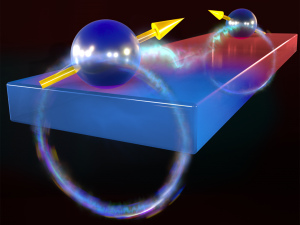Jan. 8, 2024 — When you push a button to open a garage door, it doesn’t open every garage door in the neighborhood; that’s because the opener and the door are communicating using a specific microwave frequency, a frequency no other nearby door is using.

Researchers from the University of Chicago, the US Department of Energy’s (DOE) Argonne National Laboratory, the University of Iowa, and Tohoku University in Japan have begun to develop devices that could use the same principles—sending signals through magnets instead of through the air—to connect individual qubits across a chip, as reported in a new paper published in the Proceedings of the National Academy of Sciences.
“This is a proof of concept, at room temperature, of a scalable, robust quantum technology that uses conventional materials,” said David Awschalom, the Liew Family Professor in Molecular Engineering and Physics at the University of Chicago’s Pritzker School of Molecular Engineering; the director of the Chicago Quantum Exchange; the director of Q-NEXT, a DOE Quantum Information Science Center hosted at Argonne; and the principal investigator of the project. “The beauty of this experiment is in its simplicity, and its use of well-established technology to engineer and ultimately entangle quantum devices.”
Connecting qubits through quantum entanglement is necessary to build a quantum computer, but it can often be tricky. With nitrogen vacancy (NV) centers—defects in diamond that can be used as qubits—the challenge is that in order to talk to each other, they need to be very, very close together. The normal quantum interaction between NV centers has a maximum range of only a few nanometers—one-thousandth the width of a hair—and when the NV centers are that close together, they can’t be engineered into a useful configuration.
“You need to be able to get your hands on things in there to connect wires and make a device,” said Michael Flatté, a professor of physics and astronomy at the University of Iowa who contributed to the work. Flatté is also the chief scientist at quantum technology company QuantCAD LLC, a Chicago Quantum Exchange corporate partner. “And nanometers is just too close for that.”
That’s where magnets come in.
Two years ago, Flatté and his collaborators published a theoretical paper that proposed using a magnetic material to make a quantum connection between NV centers so that they could be entangled while further apart. The normal interaction between two NV centers involves microwaves—in this proposed device, the magnet receives the microwave from the NV center and transmits it via “magnon” to the NV on the other side.
In a magnet, the spins of all the electrons inside it point in the same direction, like stalks of grain all pointing upward. A magnon is a slight wave disturbance through those spins, like a wave the wind would make across the field of grain. Magnons can go much further than nanometers—even a thousand times farther, in fact, to many micrometers.
“The micrometer scale is pretty interesting because it’s the typical scale of many integrated electronic devices, such as silicon transistors in a computer chip,” said Flatté. “So if you were to make things of that size, then you could get a reasonable number of them on a chip.”
Connecting NV center qubits with magnets also allows for selective interaction—if two qubits in the quantum computer talked at a slightly different frequency, they could entangle without disturbing or being affected by the other qubits, even if there were other qubits between them. This capability is extremely important for the kind of complex work scientists want quantum computers to perform.
This experiment by Awschalom and his collaborators successfully verified that the NV center could “talk” to the magnetic material, transmitting its microwave as a magnon. Additionally, the numbers matched almost perfectly with what was predicted in the theoretical paper two years ago.
“This work is good synergy between experiment and theory,” said Masaya Fukami, first author on the paper. Fukami was a postdoc at the Pritzker School of Molecular Engineering at UChicago during the experiment and now works at quantum computing company PsiQuantum. “I was really impressed with how well the model predicted the experiment. It gives me a lot of confidence about this system.”
Now that they’ve established that the NV center can talk to the magnet, the next step is to put another NV center on the other side and see if the magnet can mediate a quantum connection between the two.
“This is the first integration modality with magnets,” Flatté said. “I think it’s a really powerful approach which could also be applied to other solid state qubit systems in principle.”
Source: Meredith Fore, CQE


























































